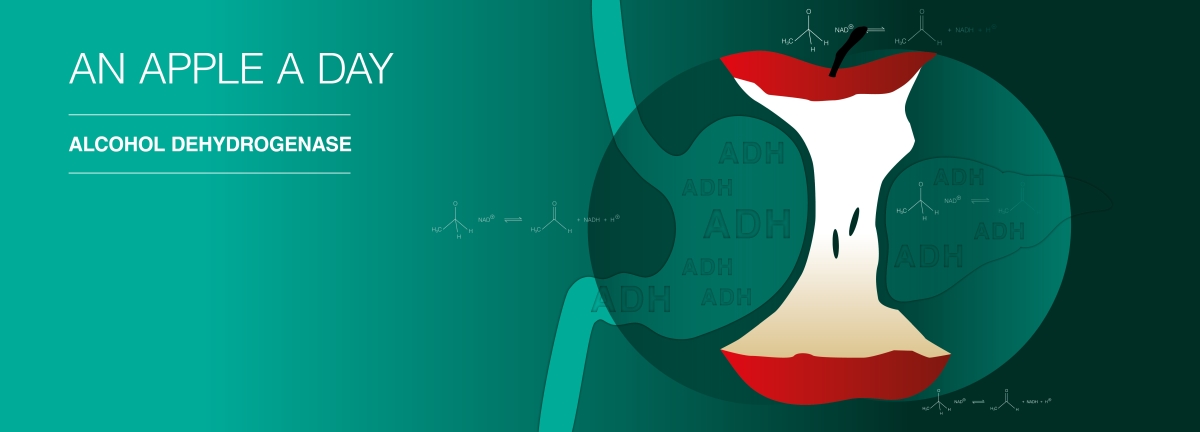
When drinking leaves you feeling thirsty:
Even clear alcohol can be a clouded pleasure
Or
How an enzyme ensures that we can enjoy a poisonous pleasure
“The best magnifying glasses for the pleasures of this world are those you drink from.” So goes the quote from Joachim Ringelnatz, who has preserved this observation for posterity. Especially now that the days are longer and the nights are shorter, we often find ourselves sitting out on the balcony or in our gardens with a glass of alcohol in hand.
So there’s no better time to get to the bottom of what’s in our glasses.
After all, alcohol’s a particularly unique drug that has two sides to it – a merry one, but also a much more dangerous one. Nowadays, it’s the latter that’s receiving increasing attention, and with it, the main ingredient in alcoholic beverages: The cell poison ethyl alcohol, more commonly known by its short name “ethanol”. Despite these recent re-evaluations, however, alcohol has unequivocally been a beverage of choice for humans all throughout all history. So why do we drink alcohol at all, and why can we tolerate at least a little bit of it?
Water was there for washing, not drinking
It’s worth nothing that neither the Bible nor the ancient Greek epics mention water as a drink, with the exception of spring water from the mountains for weary hikers and shepherds. The reason for this was likely due to the quality of the water that was available. Even up until the 19th century, the frequent contamination of water remained a largely unsolved problem that discouraged its consumption. Wherever people lived together, the available water was usually polluted and often contaminated by all kinds of waste, faeces and dead animals.
It therefore shouldn’t be a surprise that the predecessors of modern beers and wines weren’t just drunk to evoke a pleasant feeling, but above all to quench thirst. In addition, these slightly alcoholic beverages were often better tolerated and healthier than water – something our ancestors discovered quite early on, as demonstrated by the first evidence of the deliberate cultivation of wine around 6000 BC in the area of present-day Armenia. But the question remains as to why these people were able to tolerate ethanol at all, given its toxicity.
It’s all thanks to an enzyme
Alcohol is obtained by fermenting sugar from sugary and starchy fruits and seeds.
Although the alcohol content varies depending on the type of drink, even the smallest of amounts can be toxic to our cells. The reason we’re still able to consume it comes down to the enzyme alcohol dehydrogenase (ADH). This enzyme, which belongs to a group known as oxidoreductases, catalyses the final step of alcoholic fermentation in yeast – the chemical reduction of acetaldehyde to ethanol. But ADH also catalyses the reverse reaction – the oxidation of ethanol to acetaldehyde with NAD+ as a hydrogen acceptor – thus rendering ethanol harmless in many organisms (in certain quantities, at least).
In the human body, ADH is found mainly in the liver, but also in the stomach. However, the amount of ethanol that is directly neutralized in the stomach is very small; most of the ethanol is actually transferred via the mucous membranes of the digestive system, starting in the mouth, directly into the blood, which transports it throughout the body and into the body fluids of the tissues. The highest blood alcohol concentration is reached after about 45–75 minutes.
The amount of ADH in the body varies from person to person and determines how much alcohol a person can tolerate. Only about 2% of the alcohol taken in is excreted through breathing;
the vast remainder is instead metabolised by ADH in the liver and thus slowly broken down. It’s useful enzyme to have evolved with, for sure – but how did it come about?
It’s not just humans – the whole animal kingdom likes a drink
For one thing, ADH simply provides yeast cells with a way to survive in a very sugary environment. The large amount of sugar, which is also toxic in high concentrations, is automatically absorbed and eliminated in a metabolic sideline. The reverse reaction then allows the yeast cell a certain flexibility and the option to simply reintroduce the ethanol produced as waste into the metabolism in a productive way. For another, it’s also important for survival, since ethanol is toxic to yeast cells at concentrations as high as 19%.
But why is ADH a tried and tested enzyme throughout the animal world? It’s not uncommon for other animals to get drunk, in some form. Butterflies and insects sometimes like to feed on nectar that contains alcohol. Moose have been found in a drunken state after consuming alcoholic, fermented apples. Monkeys too are known to be enthusiastic about fermented fruit, and even birds sometimes get a little tipsy from fermented berries, to the point where they even have to stop flying for while. However, some bats can tolerate an above-average percentage of alcohol in their blood and still fly around safely.
The phenomenon of alcohol consumption in the animal kingdom is prevalent enough that it even made it onto the big screen, in the 1974 film “Animals Are Beautiful People” by Jamie Uys.
A clouded pleasure
Even though we have an enzyme that allows us to tolerate it to some extent, alcohol is and remains an intoxicant with side effects and a high potential for addiction, and is often trivialised by society. Ethanol not only causes prominent diseases such as liver cirrhosis or pancreatitis, but is also responsible for approximately 200 other different diseases and disorders.
As with any drug, the dose makes the poison – or rather, ensures that the level of intoxication remains a level of enjoyment.
But remember, there’s plenty of other ways to put yourself at ease without incurring any side effects. Our Carl ROTH shop has everything you need to feel good about yourself and fully taken care of.
https://www.spektrum.de/lexikon/biologie-kompakt/alkohol-dehydrogenase/411
https://www.spektrum.de/magazin/kleine-kulturgeschichte-des-alkohols/824773
https://www.dhs.de/fileadmin/user_upload/pdf/Broschueren/FS_Alkohol_gesundh-Risiken.pdf
https://www.chemie.de/lexikon/Alkoholdehydrogenase
https://naturschutz.ch/community/natur-bewegt-wenn-tiere-betrunken-sind/171589


